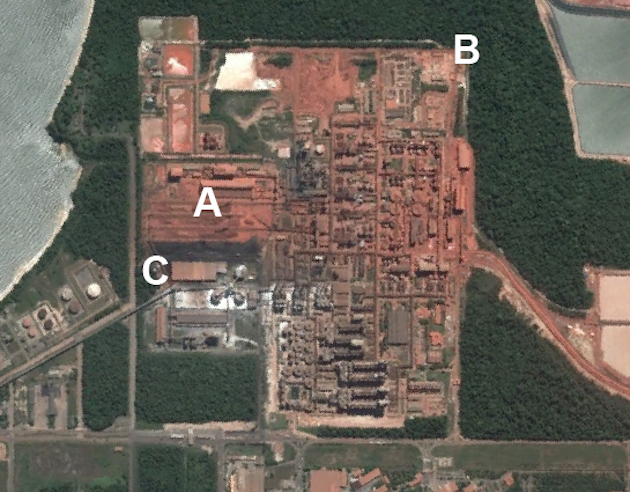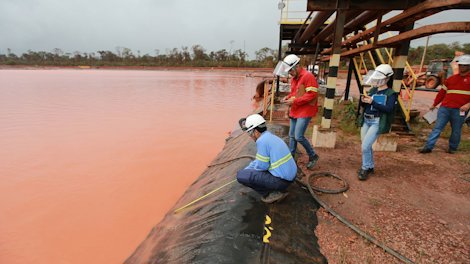The rain water that falls inside the Alunorte refinery area is to be collected and processed in the refinery’s water treatment plant before being released into the Pará river. However, in order to manage the situation and safeguard the treatment of water from the bauxite residue deposits during and following the heavy rainfall in February, Alunorte discharged partly treated rainwater from the refinery area as an emergency measure. This was done through an old water channel (“Canal Velho”), the use of which was unlicensed by the environmental agency in the state of Pará (SEMAS – the Secretariat of Environment and Sustainability of Pará). There were also two incidents of untreated rainwater being discharged from the refinery area.
We tasked the environmental consultancy SGW Services to review the environmental impact of these three incidents, and they concluded that there were no indication or evidence of contamination to the nearby local communities.

1. Refinery area
2. Bauxite residue storage area DRS1
3. Bauxite residue storage area DRS2
4. Licensed discharge to Pará river
5. Wastewater treatment plant

A. Unlicenced discharge from Calan Velho
B. Flooded area and disused pipe
C. Coal storage shed
Discharge of rainwater through ‘Canal Velho’
During the heavy rainfall, the containment basins used to collect the excess rainwater from the refinery area were reaching maximum capacity, as was the water treatment plant. Alunorte therefore chose to discharge partly treated rainwater through Canal Velho to alleviate the pressure on the water treatment plant. This was done on February 17 and periodically between February 20-25.
The water treatment plant at Alunorte is used both to treat any rainwater falling on the refinery area, and the water that has been drained from the bauxite residue deposits. The discharge of rainwater from the refinery area was done as an emergency measure to ensure that the water treatment plant would have sufficient capacity to process and treat all the water that had been in contact with the bauxite residue deposits.
The rainwater was pH treated at the inlet to Canal Velho, before it was released and then merged with water from the water treatment plant, as well as surface water from the Albras aluminium plant.
Alunorte has license from ANA (National Agency of Waters) to use Canal Velho and had applied for a license from the environmental agency in the state of Pará (SEMAS – the Secretariat of Environment and Sustainability of Pará to use this canal in emergencies, but it had not been granted at the time of the flooding.
The environmental consultancy SGW Services, which later studied the impact of the heavy rainfall, stated that Alunorte’s decision to release the rain water was the best course of action in such a situation.
“During the second period of rain, I mentioned with those 150 millimeters of rain in three hours, during this moment, all the containment basins of the plant went really full. And the wastewater treatment plant was in maximum capacity of treatment. There was a real risk of an overflow in the whole plant. In my opinion, they did the best they could do in that situation. When they decided to discharge this extra rain that was coming to the plant, they were sending out the cleanest water available in the plant. Otherwise, this would be mixture with the other contaminated water and for sure it would be worse.”
— Sidney Sairafi Aluani, SGW Services, 9 April presentation of report
Hydro commissioned the environmental consultancy SGW Services to review the possible environmental impact of the discharge. SGW Services found that this discharge into Canal Velho brought no impact to the Pará river.
Alunorte notified the environmental authority in Pará (SEMAS, the Secretariat of Environment and Sustainability) about the use of Canal Velho, but did not inform the local communities about this action.
We have apologized to the local communities about our lack of information to them and have improved our emergency plans so that this will not happen again.
“The local communities have not received the information they deserve, and they have not found us trustworthy. For that, I apologize. We accept that to build trust, we will have to make changes in our own attitudes, in our actions, and in our ways of working with the local communities.”
— Hydro CEO and President Svein Richard Brandtzæg, Hydro press release 19 March
Rainwater leaked through cracks in a sealed pipe at the refinery area
During an inspection of Alunorte on 18 February, a disused construction pipe was discovered in a corner of the refinery area (known as ‘Area 45’). This pipe was no longer in use and was supposed to have been entirely sealed, but had thin cracks in its concrete cover. During the heavy rainfall, this area became flooded as the pumps broke down due to a power outage. As the water accumulated, some water seeped through the cracks in the disused pipe to the other side of the refinery area fence.
After the pipe was resealed, Alunorte commissioned environmental consultancy Enviro-Tec to analyze the water and soil outside the refinery area. Enviro-Tec concluded that the rain water that had leaked through this pipe had not caused any negative impact to the soil.
The environmental consultancy SGW Services also concluded that the leakage from this pipe did not reach nor cause any contamination to the Murucupi river.

Discharge of rainwater from the roof of the coal storage shed
There was an unlicensed connection between the coal storage shed of the Alunorte refinery and a licensed drainage canal from the adjacent Albras primary aluminium plant. This meant that rainwater that fell on the coal storage shed area at Alunorte was not lead to the water treatment plant,but rather flowed through this internal channel into the Pará river. An additional inflow of water to the channel from the former hydrate storage area was also discovered. Both inflows of water to this internal canal were closed upon discovery.

Updated: May 15, 2024








